Forest Single-Frame Remote Sensing Image Super-Resolution Using GANs
Abstract
:1. Introduction
- We introduce MSRB as a feature extraction component to enhance feature extraction capabilities by obtaining image features at different scales. MSRB constructs a dual-branch network, where different branches use distinct convolution kernels. These branches share information with each other, enabling the adaptive detection of image features at different scales.
- We propose GAM Attention and incorporate it into the VGG network to capture more precise feature dependencies in both spatial and channel domains.
- We apply Meta ACONC as the activation function within the VGG network. By dynamically learning the parameters of the Meta ACONC activation function for each neuron, it is designed to enhance network feature representation. Additionally, Ghost convolution is employed to optimize the convolution layers in the network, reducing network parameters and computational complexity.
- We conduct a multitude of comparative experiments with mature and advanced models. When tested on the high-resolution DIV2K dataset and the single-frame forest remote sensing image dataset LOVEDA, our proposed model outperforms some mainstream models in terms of perceived image quality. It exhibits higher image realism, with an improvement of 0.709/2.213 dB in PSNR and an increase of 0.032/0.142 in SSIM; LPIPS shows a decrease of 0.03/0.013 compared to SRGAN, while performing on par with Real-ESRGAN in terms of metrics. Significantly, it achieves faster processing speeds. These results demonstrate that our proposed model efficiently attains competitive performance in the context of single-frame forest remote sensing images.
- This model contributes to improving the quality and information content of remote sensing images, providing a powerful tool for better understanding and preserving Earth’s forest ecosystems.
2. Related Work
3. Method
3.1. Method Overview
3.2. Multi-Scale Residual Block (MSRB)
3.3. Generator Loss Function
3.4. Discriminator Design
3.4.1. Novel Attention Mechanism (GAM Attention)
3.4.2. Network Performance and Training Enhancement
3.5. Evaluation Metrics
4. Experimental Comparison and Analysis
4.1. Experimental Environment and Training Data
4.2. Training Process
4.3. Comparative Experiments
4.4. Ablation Experiments
5. Conclusions
Author Contributions
Funding
Data Availability Statement
Acknowledgments
Conflicts of Interest
References
- Dong, C.; Loy, C.C.; He, K.M.; Tang, X.O. Image super-resolution using deep convolutional networks. IEEE Trans. Pattern Anal. Mach. Intell. 2016, 38, 295–307. [Google Scholar] [CrossRef] [PubMed]
- Dong, C.; Loy, C.C.; Tang, X.O. Accelerating the superresolution convolutional neural network. In Computer Vision ECCV 2016; Springer: Amsterdam, The Netherlands, 2016; pp. 391–407. [Google Scholar]
- Kim, J.; Lee, J.K.; Lee, K.M. Accurate image super-resolution using very deep convolutional networks. In Proceedings of the 2016 IEEE Conference on Computer Vision and Pattern Recognition, Las Vegas, NV, USA, 27–30 June 2016; pp. 1646–1654. [Google Scholar]
- Zhang, Y.; Li, K.; Li, K.; Wang, L.C.; Zhong, B.N.; Fu, Y. Image super-resolution using very deep residual channel attention networks. In Computer Vision—ECCV 2018; Springer: Heidelberg, Germany, 2018; pp. 286–301. [Google Scholar]
- Lim, B.; Son, S.; Kim, H.; Nah, S.; Lee, K.M. Enhanced deep residual networks for single image super-resolution. In Proceedings of the 2017 IEEE Conference on Computer Vision and Pattern Recognition Workshops, Honolulu, HI, USA, 21–26 July 2017; pp. 1132–1140. [Google Scholar]
- Creswell, A.; White, T.; Dumoulin, V.; Arulkumaran, K.; Sengupta, B.; Bharath, A.A. Generative adversarial networks, an overview. IEEE Signal Process. Mag. 2018, 35, 53–65. [Google Scholar] [CrossRef]
- Ledig, C.; Theis, L.; Huszár, F.; Caballero, J.; Cunninghan, A.; Acosta, A.; Aitken, A.; Tejani, A.; Totz, J.; Wang, Z.; et al. Photo-realistic single image super-resolution using a generative adversarial network. In Proceedings of the 2017 IEEE Conference on Computer Vision and Pattern Recognition, Honolulu, HI, USA, 21–26 July 2017; pp. 105–114. [Google Scholar]
- Ratliff, L.J.; Burden, S.A.; Sastry, S.S. Characterization and computation of local Nash equilibria in continuous games. In Proceedings of the 2013 51st Annual Allerton Conference on Communication, Control, and Computing (Allerton), Monticello, IL, USA, 2–4 October 2013; pp. 917–924. [Google Scholar]
- Keys, R. Cubic convolution interpolation for digital image processing. IEEE Trans. Acoust. Speech Signal Process. 1981, 29, 1153–1160. [Google Scholar] [CrossRef]
- Prashanth, H.S.; Shashidhara, H.L.; Murthy, K.N.B. Image scaling comparison using universal image quality index. In Proceedings of the 2009 International Conference on Advances in Computing, Control, and Telecommunication Technologies, Bangalore, India, 28–29 December 2009; pp. 859–863. [Google Scholar]
- Shah, Z.H.; Müller, M.; Wang, T.C.; Scheidig, P.M.; Schneider, A.; Schüttpelz, M.; Huser, T.; Schenck, W. Deep-learning based denoising and reconstruction of super-resolution structured illumination microscopy images. Photonics Res. 2021, 9, B168–B181. [Google Scholar] [CrossRef]
- Dai, S.; Han, M.; Wu, Y.; Gong, Y. Bilateral back-projection for single image super resolution. In Proceedings of the 2007 IEEE International Conference on Multimedia and Expo, Beijing, China, 2–5 July 2007; pp. 1039–1042. [Google Scholar]
- Zhang, H.; Zhang, Y.; Li, H.; Huang, T.S. Generative Bayesian image super resolution with natural image prior. IEEE Trans. Image Process. 2012, 21, 4054–4067. [Google Scholar] [CrossRef] [PubMed]
- Chang, H.; Yeung, D.Y.; Xiong, Y. Super-resolution through neighbor embedding. In Proceedings of the 2004 IEEE Computer Society Conference on Computer Vision and Pattern Recognition, Washington, DC, USA, 27 June–2 July 2004; Volume 1, pp. I-275–I-282. [Google Scholar]
- Huang, G.; Liu, Z.; Maaten, L.V.D.; Weinberger, K.Q. Densely connected convolutional networks. In Proceedings of the 2017 IEEE Conference on Computer Vision and Pattern Recognition (CVPR), Honolulu, HI, USA, 21–26 July 2017; pp. 2261–2269. [Google Scholar]
- Chen, H.; Wang, Y.; Guo, T.; Xu, C.; Deng, Y.; Liu, Z.; Ma, S.; Xu, C.; Xu, C.; Gao, W. Pre-trained image processing transformer. In Proceedings of the 2021 IEEE/CVF Conference on Computer Vision and Pattern Recognition (CVPR), Nashville, TN, USA, 19–25 June 2021; pp. 12294–12305. [Google Scholar]
- Arjovsky, M.; Bottou, L. Towards principled methods for training generative adversarial networks. arXiv 2017, arXiv:1701.04862. [Google Scholar]
- Wang, X.; Yu, K.; Wu, S.; Gu, J.; Liu, Y.; Dong, C.; Qiao, Y.; Loy, C.C. Esrgan, enhanced super-resolution generative adversarial networks. In Computer Vision–ECCV 2018 Workshops; Springer: Munich, Germany, 2018; pp. 63–79. [Google Scholar]
- Li, J.; Fang, F.; Mei, K.; Zhang, G. Multi-scale Residual Network for Image Super-Resolution. In Proceedings of the European Conference on Computer Vision (ECCV), Munich, Germany, 8–14 September 2018; pp. 517–532. [Google Scholar]
- Hu, J.; Shen, L.; Albanie, S.; Sun, G.; Wu, E. Squeeze-and-Excitation Networks. arXiv 2017, arXiv:1709.01507v4. [Google Scholar]
- Wang, Q.; Wu, B.; Zhu, P.; Li, P.; Zuo, W.; Hu, Q. ECA-Net, efficient channel attention for deep convolutional neural networks. In Proceedings of the IEEE/CVF Conference on Computer Vision and Pattern Recognition (CVPR), Seattle, WA, USA, 14–19 June 2020; pp. 11531–11539. [Google Scholar]
- Woo, S.; Park, J.; Lee, J.Y.; Kweon, I.S. CBAM, convolutional block attention module. arXiv 2018, arXiv:1807.06521v2. [Google Scholar]
- Fu, J.; Liu, J.; Tian, H.; Li, Y.; Bao, Y.; Fang, Z.; Lu, H. Dual Attention Network for Scene Segmentation. arXiv 2019, arXiv:1809.02983v4. [Google Scholar]
- Zoph, B.; Le, Q.V. Neural Architecture Search with Reinforcement Learning. arXiv 2017, arXiv:1611.01578v2. [Google Scholar]
- Goodfellow, I.J.; Warde-Farley, D.; Mirza, M.; Courville, A.; Bengio, Y. Maxout Networks. arXiv 2013, arXiv:1302.4389v4. [Google Scholar]
- Han, K.; Wang, Y.; Tian, Q.; Guo, J.; Xu, C.; Xu, C. Ghostnet, More features from cheap operations. In Proceedings of the IEEE/CVF Conference on Computer Vision and Pattern Recognition, Seattle, WA, USA, 14–19 June 2020; pp. 1580–1589. [Google Scholar]
- Huynh-Thu, Q.; Ghanbari, M. Scope of validity of PSNR in image/video quality assessment. Electron. Lett. 2008, 44, 800–801. [Google Scholar] [CrossRef]
- Wang, Z.; Bovik, A.C.; Sheikh, H.R.; Simoncelli, E.P. Image quality assessment, from error visibility to structural similarity. IEEE Trans. Image Process. 2004, 13, 600–612. [Google Scholar] [CrossRef] [PubMed]
- Zhang, R.; Isola, P.; Efros, A.A.; Shechtman, E.; Wang, O. The unreasonable effectiveness of deep features as a perceptual metric. In Proceedings of the IEEE Conference on Computer Vision and Pattern Recognition, Salt Lake City, UT, USA, 18–22 June 2018; pp. 586–595. [Google Scholar]
- Agustsson, E.; Timofte, R. NTIRE 2017 challenge on single image super-resolution, dataset and study. In Proceedings of the 2017 IEEE Conference on Computer Vision and Pattern Recognition Workshops, Honolulu, HI, USA, 21–26 July 2017; pp. 1122–1131. [Google Scholar]
- Wang, J.; Zheng, Z.; Ma, A.; Lu, X.; Zhong, Y. LoveDA: A remote-sensing land-cover dataset for domain adaptive semantic segmentation. arXiv 2021, arXiv:2110.08733. [Google Scholar]
- Kingma, D.P.; Ba, J. Adam: A Method for Stochastic Optimization. arXiv 2017, arXiv:1412.6980v9. [Google Scholar]
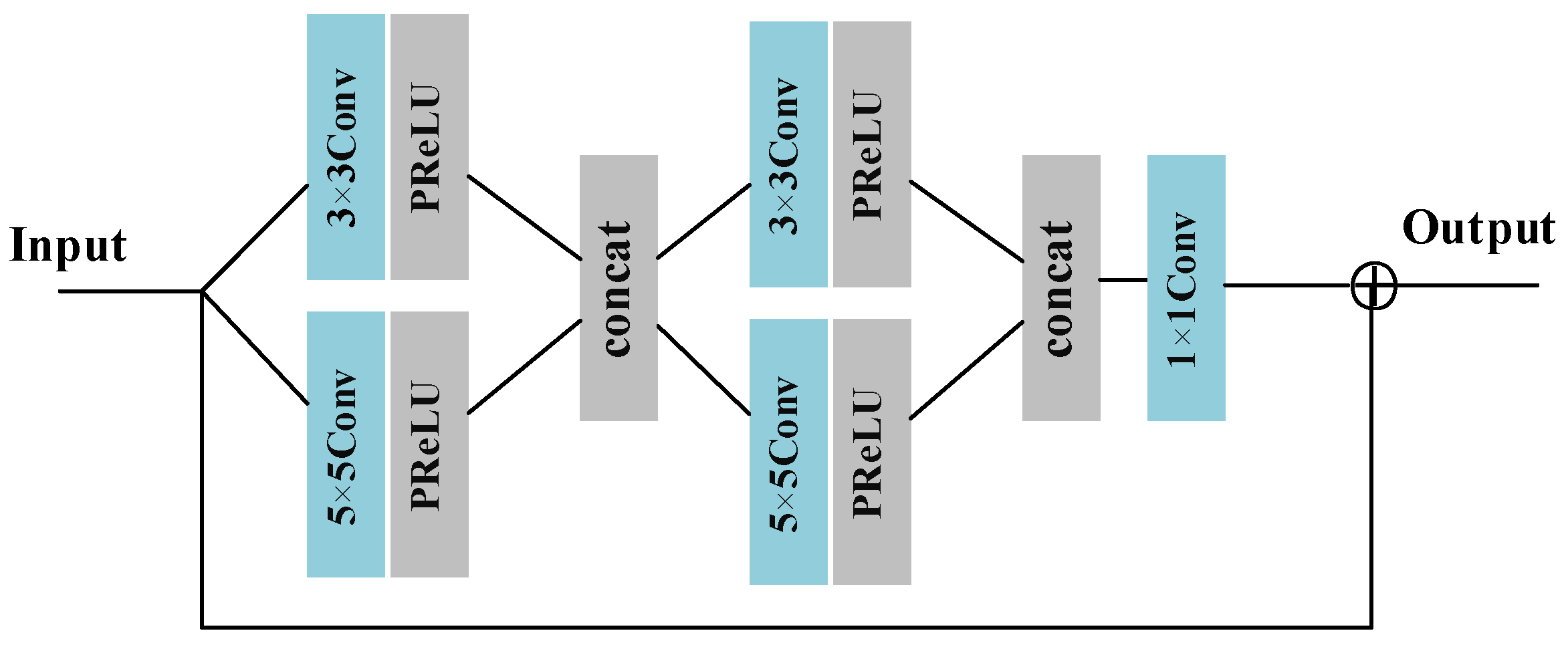

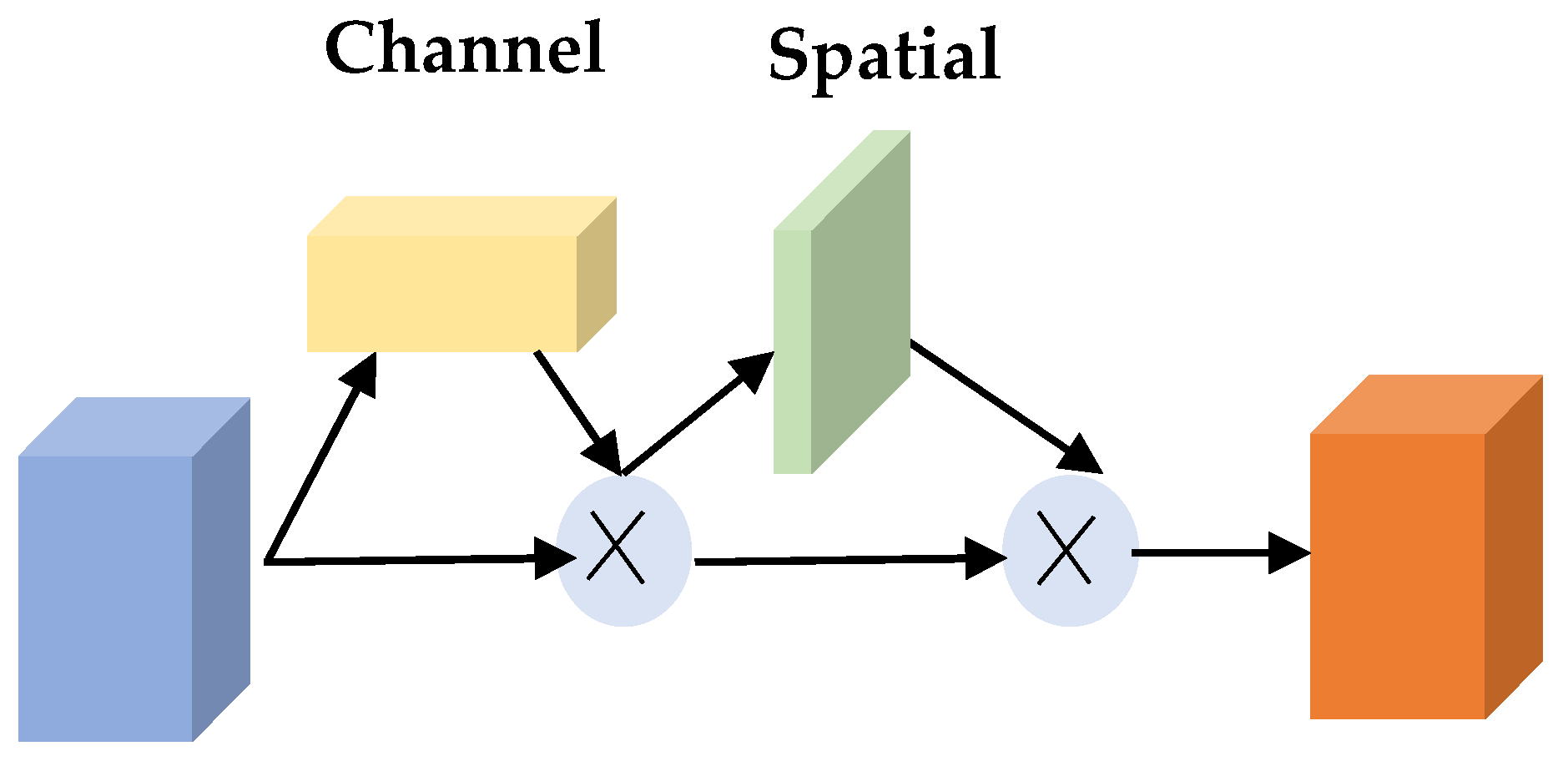




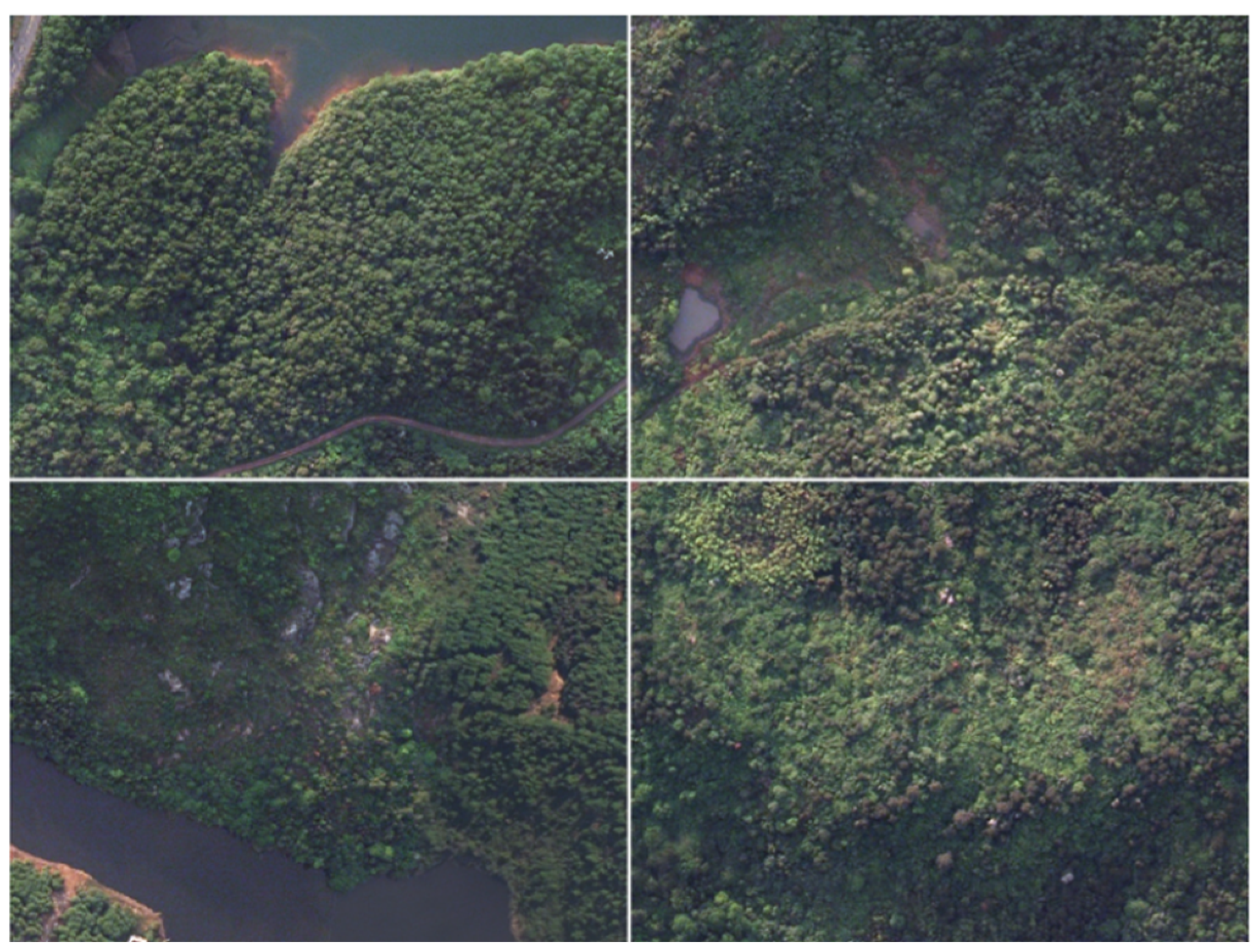
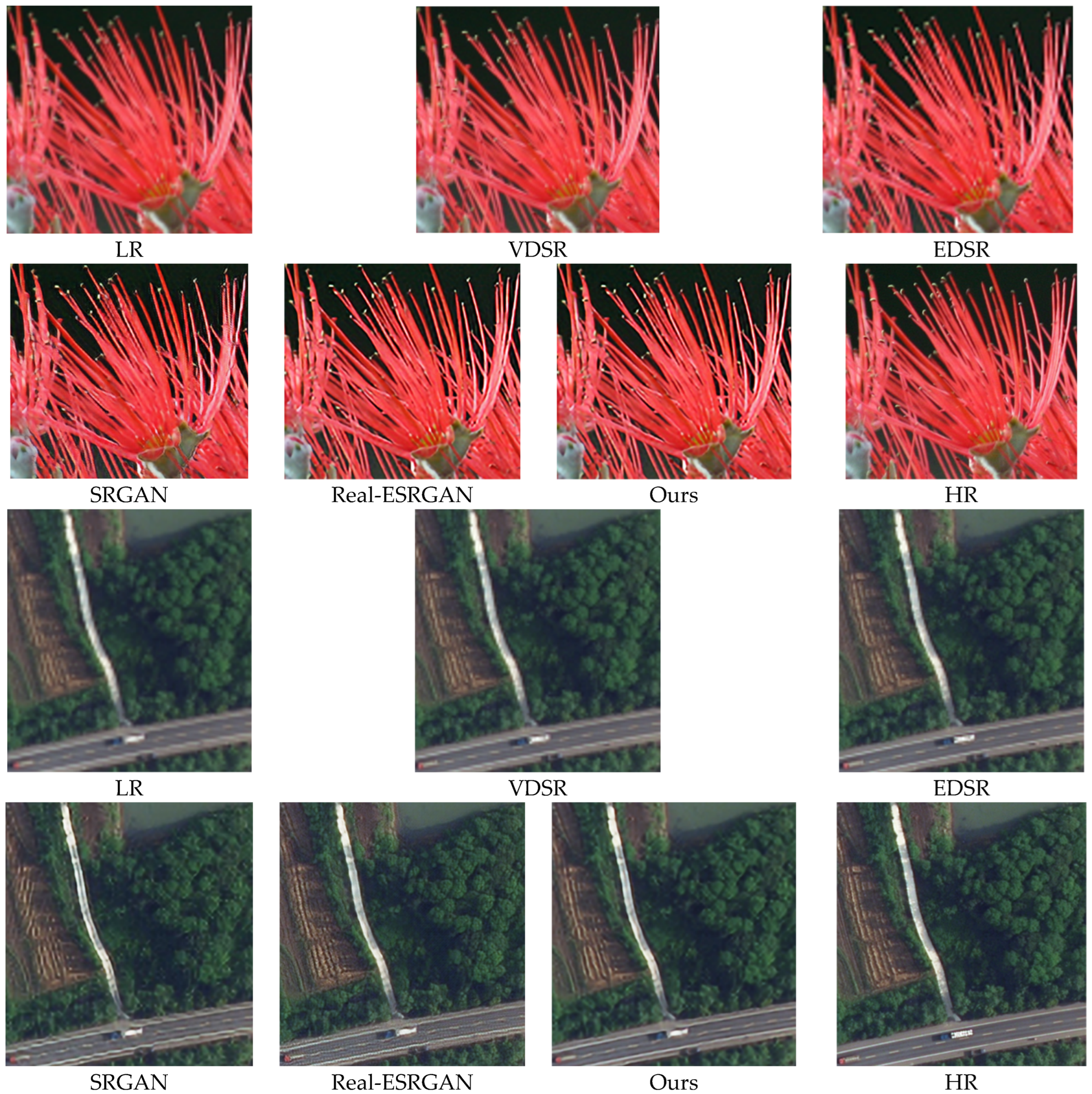

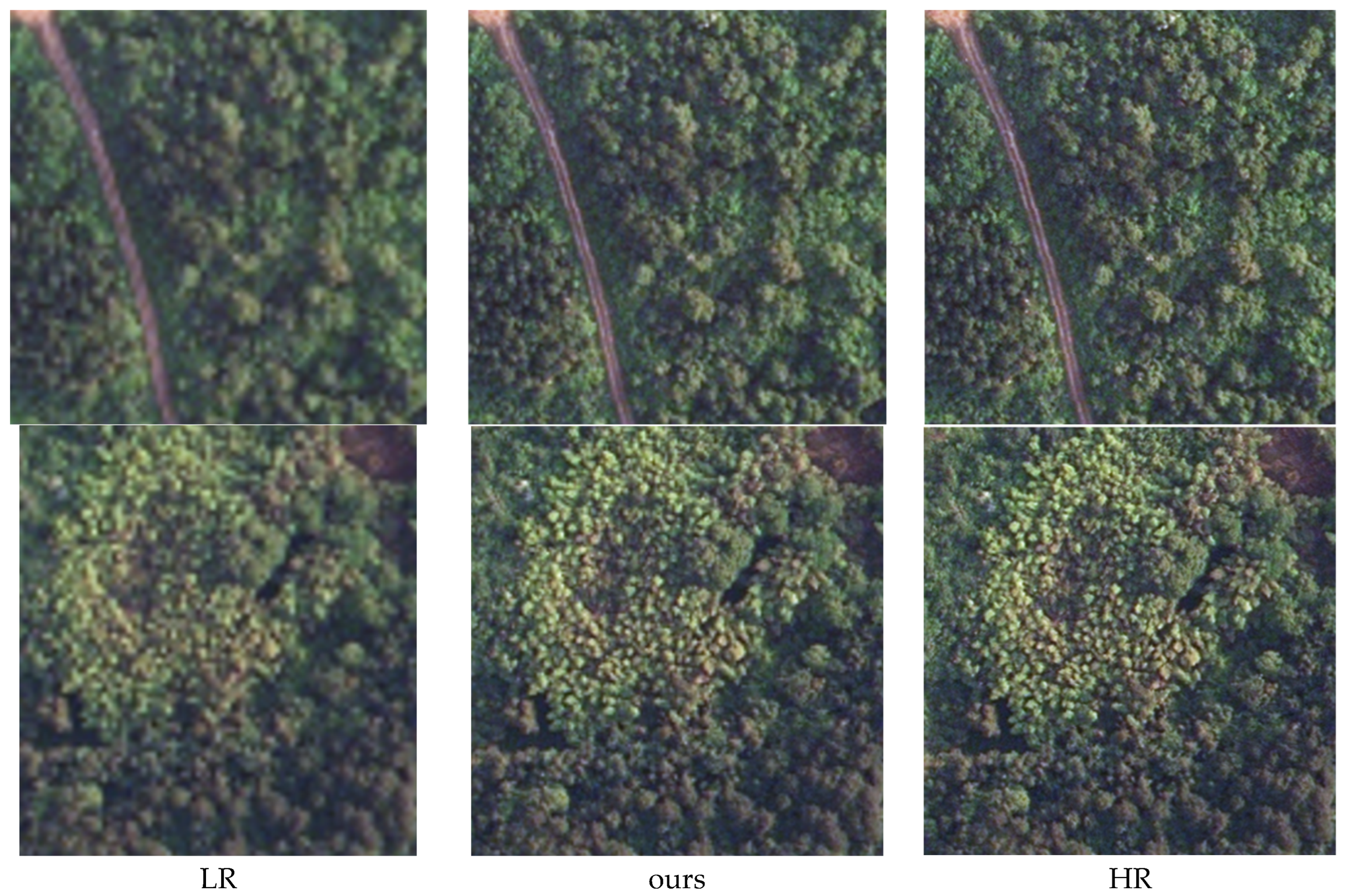
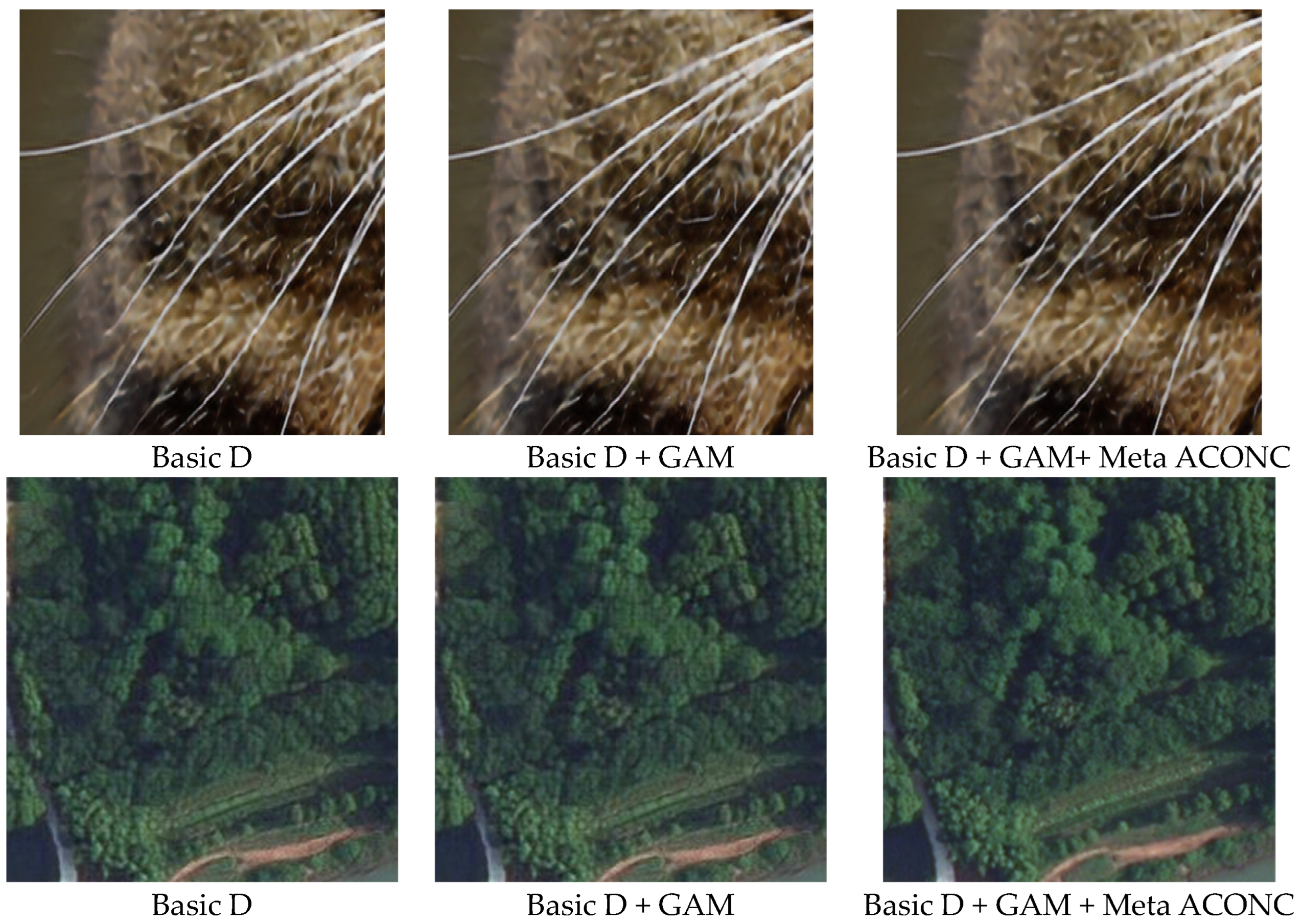
| Dataset | Algorithm | VDSR | EDSR | SRGAN | Real-ESRGAN | Ours |
|---|---|---|---|---|---|---|
| DIV2K | PSNR/dB | 24.843 | 25.141 | 27.353 | 28.374 | 28.062 |
| SSIM | 0.542 | 0.597 | 0.757 | 0.803 | 0.789 | |
| LPIPS | 0.519 | 0.492 | 0.343 | 0.315 | 0.313 | |
| LOVEDA | PSNR/dB | 21.349 | 21.947 | 23.685 | 25.907 | 25.898 |
| SSIM | 0.351 | 0.383 | 0.522 | 0.673 | 0.664 | |
| LPIPS | 0.593 | 0.560 | 0.407 | 0.399 | 0.394 |
| Dataset | VDSR | EDSR | SRGAN | Real-ESRGAN | Ours |
|---|---|---|---|---|---|
| DIV2K | 118.4 | 111.19 | 81 | 22.7 | 44 |
| LOVEDA | 130.61 | 121 | 90.43 | 31.4 | 50.4 |
| Dataset | Algorithm | VDSR + GAM | EDSR + GAM | SRGAN + GAM |
|---|---|---|---|---|
| DIV2K | PSNR/dB | 24.955 | 25.268 | 27.361 |
| SSIM | 0.560 | 0.611 | 0.764 | |
| LPIPS | 0.508 | 0.480 | 0.334 | |
| LOVEDA | PSNR/dB | 21.226 | 22.101 | 23.775 |
| SSIM | 0.339 | 0.392 | 0.513 | |
| LPIPS | 0.583 | 0.553 | 0.394 |
| Dataset | Algorithm | Basic D | Basic D + GAM | Basic D + GAM + Meta ACONC |
|---|---|---|---|---|
| DIV2K | PSNR/dB | 27.829 | 27.924 | 28.062 |
| SSIM | 0.777 | 0.785 | 0.789 | |
| LPIPS | 0.322 | 0.316 | 0.313 | |
| LOVEDA | PSNR/dB | 25.169 | 25.467 | 25.898 |
| SSIM | 0.597 | 0.629 | 0.664 | |
| LPIPS | 0.382 | 0.380 | 0.394 |
Disclaimer/Publisher’s Note: The statements, opinions and data contained in all publications are solely those of the individual author(s) and contributor(s) and not of MDPI and/or the editor(s). MDPI and/or the editor(s) disclaim responsibility for any injury to people or property resulting from any ideas, methods, instructions or products referred to in the content. |
© 2023 by the authors. Licensee MDPI, Basel, Switzerland. This article is an open access article distributed under the terms and conditions of the Creative Commons Attribution (CC BY) license (https://creativecommons.org/licenses/by/4.0/).
Share and Cite
Zhao, Y.; Zhang, S.; Hu, J. Forest Single-Frame Remote Sensing Image Super-Resolution Using GANs. Forests 2023, 14, 2188. https://doi.org/10.3390/f14112188
Zhao Y, Zhang S, Hu J. Forest Single-Frame Remote Sensing Image Super-Resolution Using GANs. Forests. 2023; 14(11):2188. https://doi.org/10.3390/f14112188
Chicago/Turabian StyleZhao, Yafeng, Shuai Zhang, and Junfeng Hu. 2023. "Forest Single-Frame Remote Sensing Image Super-Resolution Using GANs" Forests 14, no. 11: 2188. https://doi.org/10.3390/f14112188








